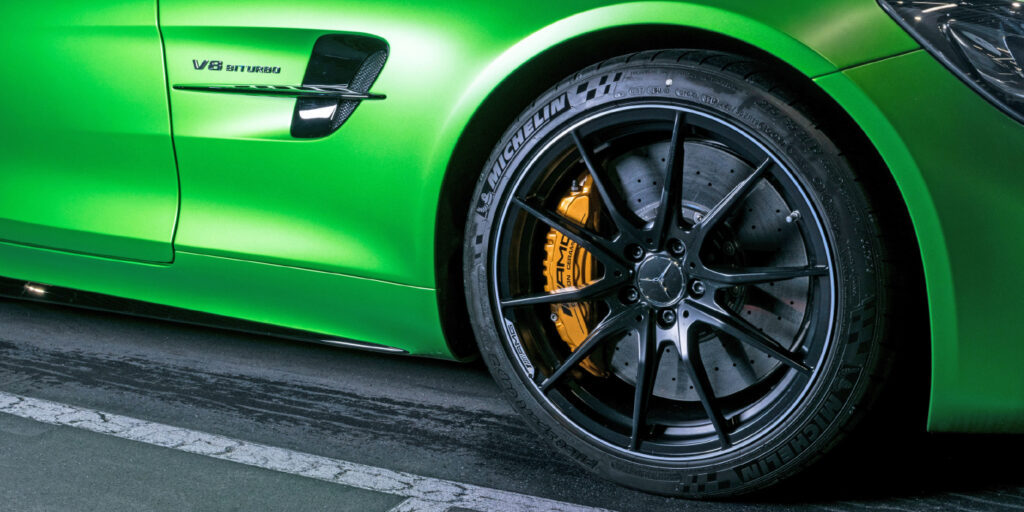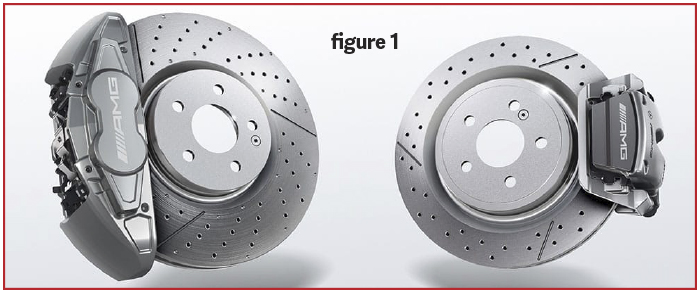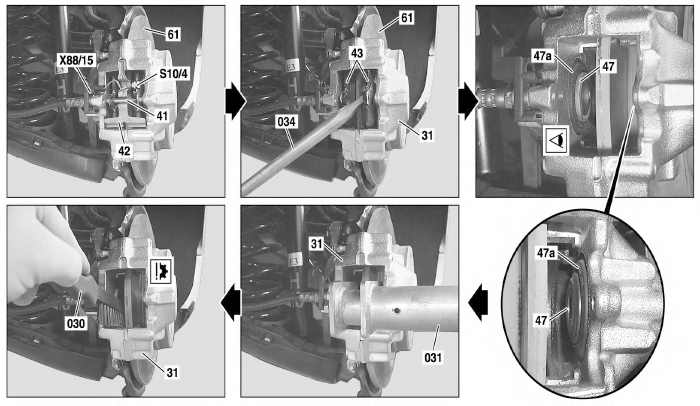AMG is the performance line of Mercedes-Benz vehicles, just like Nismo is to Nissan, and M is to BMW. I can tell you from experience that there are many exciting vehicles wearing that AMG badge. They’re powerful, luxurious and they make a sound unlike any other.
But, just like all motor vehicles, they require service from time to time. Slowing the vehicle down from high speeds takes a toll on the brakes, wearing them down over time. So, today let’s take a look at some of the things you need to know in order to service the brakes on a Mercedes-Benz AMG vehicle.
AMG Braking Systems
There are three different braking systems which are being used on late-model Mercedes-Benz AMG vehicles. Each one has its own list of pros and cons, but for our purposes we’ll focus on the differences between them.
The AMG High-Performance Braking System is the base package and consists of perforated (drilled) rotors. The AMG High-Performance Composite Braking System features ventilated, slotted and perforated composite rotors. The AMG High-Performance Compound Braking System uses two-piece carbon and ceramic compound rotors and matching brake pads. Many of these systems will utilize fixed brake calipers for both the front and rear axles, but some smaller vehicles may use floating calipers for the rear axle only (figure 1).
The largest difference between these three systems would be the cost. While an AMG High-Performance brake rotor might cost only a few hundred dollars, a carbon ceramic rotor could cost thousands! However, carbon ceramic brake rotors are extremely durable, and resistant to the types of warping or distorting which could lead to a pulsating brake pedal.
Braking System Inspection
The first (and most important) step is to check the OEM service information for any helpful information. Using the VIN to lookup replacement parts for that specific vehicle is also best practice. It is the single best way to ensure that you are ordering the right parts for your customer the first time.
During your inspection, look for any signs of sticking or seizing caliper guide pins, brackets, and hardware. Are the brake pads wearing evenly? Or, are they wedge-shaped? Are the caliper piston and boot in good shape? Or, is the rubber beginning to degrade and crack?
Check the condition of the brake fluid. Flush the system if it is discolored, murky, dirty, or has not been flushed within the last two years. Brake fluid which has been contaminated with debris or air bubbles could cause a soft or spongy brake pedal and reduced braking performance.
Remember that a fixed brake caliper must be installed with the bleeder screws facing upward. If this type of caliper is installed with the bleeders facing downward, it will be impossible to bleed the air from the system. I’ve seen this situation first-hand. It’s something that a DIYer might not notice, but as professionals we should recognize it.
Service Tips & Tricks
As a former Mercedes-Benz technician, I found it best to always open the bleeder screw on the caliper while you’re retracting the piston(s). This simple step will help to prevent any contaminants or debris inside the caliper from being pushed back through the hydraulic system. If you’re working on a fixed caliper, use a pad spreader tool to push all of the pistons back at the same time (figure 2).
There are a number of different types of calipers which are used across the Mercedes-Benz lineup. Some calipers are not designed to have grease on the contact surfaces with brake pads. This is a very important thing to know as a technician, since applying grease where it is not meant to be applied can have unintended consequences. Mercedes-Benz posted a bulletin on this subject (AR42.10-P-0161-01B), and it covers the grease requirements of brake calipers from a number of different models.
It is always a good idea to check the OEM service information beforehand. It’s the single best thing you can do to familiarize yourself with how each component should be serviced, and it could prevent a customer comeback. Take a look at TSBs for any braking- related symptoms which may have emerged as trends over time.
One such trend would be the Sensotronic Brake Control (SBC) system on W211 E-Class, W219 CLS-Class, and R230 SL-Class vehicles. The electro-hydraulic pump is located just behind the RH headlight, and it provides brake fluid at high pressure to the braking system by way of an electric motor and accumulator.
Mercedes-Benz programmed a cycle limit, or a lifespan into the SBC hydraulic pump. Once the module sees about 300,000 braking cycles, an error message appears on the dashboard. If this warning message is ignored, it could lead to a complete failure, resulting in reduced braking power or a complete loss of power assist.
If you see these messages on the dashboard, or if you find fault code “C249F – Operating time of component A713 is exceeded (or service threshold reached),” follow the diagnostic troubleshooting guide to determine if the SBC unit is in need of replacement.
Can You Turn (Cut) Drilled & Slotted Rotors?
The answer is yes, you can. You should always replace or resurface the brake rotors whenever replacing the brake pads. Doing so will maximize the service life of both components, and will allow the pads to “bed in” properly. If you leave the old, worn down rotors alone, and replace the pads alone, your customer may soon return with a squeaky or noisy brake concern.
It is not recommended to machine AMG two-piece or composite rotors. Chatter and noise for the rotor and lathe while trying to machine the rotor can create surface issues.
It’s best practice to set your brake lathe to its lowest speed setting when turning drilled and/or slotted brake rotors. This helps to keep the bit from chattering or screeching. Check the OEM service information. Make sure that the rotors meet or exceed the minimum thickness requirement, and do not exceed the maximum runout specification.
However, some shops will choose to replace the pads and rotors together rather than attempting to cut the rotors down. Think of it as risk management. If you’re not comfortable with cutting the rotors down to spec, it may be best to simply replace them. Compare the cost of the replacement parts versus your time and go from there.
















